
Catherine de' Medici was an Italian (Florentine) noblewoman born into the Medici family. She was Queen of France from 1547 to 1559 by marriage to King Henry II and the mother of French kings Francis II, Charles IX, and Henry III. The years during which her sons reigned have been called "the age of Catherine de' Medici" since she had extensive, if at times varying, influence on the political life of France.

Francis II was King of France from 1559 to 1560. He was also King of Scotland as the husband of Mary, Queen of Scots, from 1558 until his death in 1560.

Michel de l'Hôpital was a French lawyer, diplomat and chancellor during the latter Italian Wars and the early French Wars of Religion. The son of a doctor in the service of Constable Bourbon he spent his early life exiled from France at Bourbon's and then the emperors court. When his father entered the service of the House of Lorraine, he entered the patronage network of Charles, Cardinal of Lorraine. Through his marriage to Marie Morin, he acquired a seat in the Paris Parlement. In this capacity he drew up the charges for the king, concerning the defenders of Boulogne who surrendered the city in 1544, before taking a role as a diplomat to the Council of Trent in 1547. The following year he assisted Anne d'Este in the details of her inheritance to ensure she could marry Francis, Duke of Guise.

Gaspard de Coligny, seigneur de Châtillon, was a French nobleman, Admiral of France, and Huguenot leader during the French Wars of Religion. He served under kings Francis I and Henry II during the Italian Wars, attaining great prominence both due to his military skill and his relationship with his uncle, the king's favourite Anne de Montmorency. During the reign of Francis II he converted to Protestantism, becoming a leading noble advocate for the Reformation during the early reign of Charles IX.
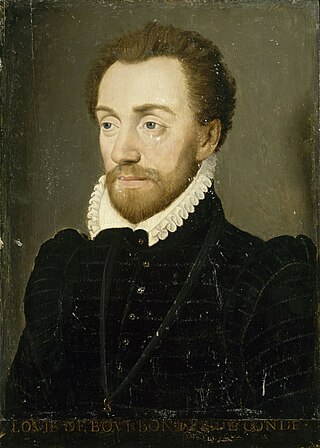
Louis de Bourbon, 1st Prince of Condé was a prominent Huguenot leader and general, the founder of the Condé branch of the House of Bourbon. Coming from a position of relative political unimportance during the reign of Henri II, Condé's support for the Huguenots, along with his leading role in the conspiracy of Amboise and its aftermath, pushed him to the centre of French politics. Arrested during the reign of Francis II then released upon the latter's premature death, he would lead the Huguenot forces in the first three civil wars of the French Wars of Religion before being executed after his defeat at the Battle of Jarnac in 1569.
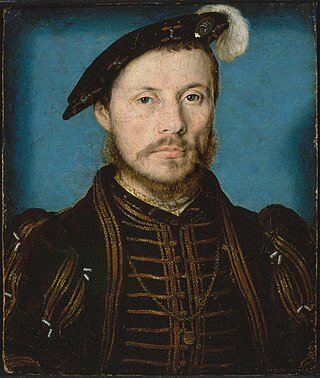
Anne de Montmorency, duc de Montmorency was a French noble, governor, royal favourite and Constable of France during the mid to late Italian Wars and early French Wars of Religion. He served under five French kings. He began his career in the latter Italian Wars of Louis XII, seeing service at Ravenna. When François, his childhood friend, ascended to the throne in 1515 he advanced as governor of the Bastille and Novara, then in 1522 was made a Marshal of France. He fought at the French defeat at La Bicocca in that year, and after assisting in rebuffing the invasion of Constable Bourbon he was captured at the disastrous Battle of Pavia. Quickly freed he worked to free first the king and then the king's sons. In 1526 he was made Grand Maître (Grandmaster), granting him authority over the king's household, he was also made governor of Languedoc. He aided in the marriage negotiations for the king's son the duc d'Orléans to Catherine de Medici in 1533. In the mid 1530s he found himself opposed to the war party at court led by Admiral Chabot and therefore retired. He returned to the fore after the Holy Roman Emperor invaded Provence, leading the royal effort that foiled his invasion, and leading the counter-attack. In 1538 he was rewarded by being made Constable of France, this made him the supreme authority over the French military. For the next two years he led the efforts to secure Milano for France through negotiation with the Emperor, however this proved a failure and Montmorency was disgraced, retiring from court in 1541.
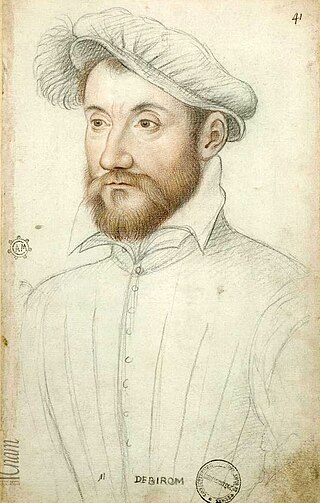
Armand de Gontaut, Baron of Biron was a soldier, diplomat and Marshal of France. Beginning his service during the Italian Wars, Biron served in Italy under Marshal Brissac and Guise in 1557 before rising to command his own cavalry regiment. Returning to France with the Peace of Cateau-Cambrésis he took up his duties in Guyenne, where he observed the deteriorating religious situation that was soon to devolve into the French Wars of Religion. He fought at the Battle of Dreux in the first civil war. In the peace that followed he attempted to enforce the terms on the rebellious governorship of Provence.
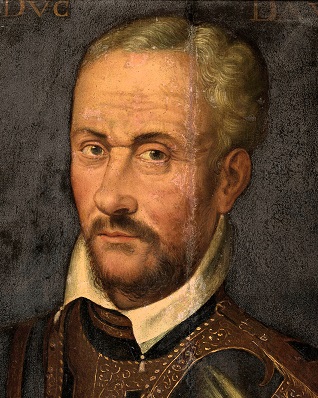
Claude II de Lorraine, duc d'Aumale was a Prince étranger, military commander and French governor, during the latter Italian Wars and the early French Wars of Religion. The son of the first Duke of Guise he started his career in a pre-eminent position in French politics as a son of one of the leading families in the court of Henri II of France. Upon the death of his father in 1550, Aumale inherited the governorship of Burgundy from his father, and the duchy of Aumale from his brother who assumed the titles of Guise. Aumale was made colonel-general of the light horse by the new king and fought in Italy, Alsace and Picardie between 1551 and 1559. While leading the light cavalry during the defence of Metz he was captured, and held for the next two years, until his mother in law Diane de Poitiers paid his ransom. He achieved success at the siege of Volpiano and played an important role in the capture of Calais for which he was rewarded with the governorship of French Piedmont.

René de Birague was an Italian then French noble, lieutenant-general, chancellor and cardinal during the latter Italian Wars and the French Wars of Religion. Born to a prominent Milanese family in 1506, his family sided with the French, and as such when Milan was occupied by Emperor Charles V they were forced to flee to French controlled Piedmont. Declared a criminal in 1536, his Milanese estates would be seized. Birague entered French service in the 1540s, being elevated to premier président of the Parlement of Turin, which in combination with his service under the French governor Marshal Brissac from 1550, afforded him immense administrative power in the French occupied territories. In 1562 with the French withdrawal from the Piedmont, he departed his post in the Parlement, however the following year would see him elevated in one of the remaining French held towns, as leader of the Supreme Council of Pignerol.

The Battle of Saint-Denis was fought on 10 November 1567 between a Royalist army and Huguenot rebels during the second of the French Wars of Religion. Although their 74 year old commander, Anne de Montmorency, was killed in the fighting, the Royalists forced the rebels to withdraw, allowing them to claim victory.

Margaret of Valois, popularly known as La Reine Margot, was a French princess of the Valois dynasty who became Queen of Navarre by marriage to Henry III of Navarre and then also Queen of France at her husband's 1589 accession to the latter throne as Henry IV.

Louis de Clermont, seigneur de Bussy d'Amboise (1549–1579) was a noble, military commander and governor during the French Wars of Religion. His great-uncle was Georges d'Amboise, who was the primary adviser to king Louis XII, as a result he inherited a range of lands from his father. Entering politics in 1568, he led a company of men-at-arms in the third civil war. In 1574 he fought in the fourth civil war in Normandy and was rewarded for his service with the office of maître de camp and three more companies.

The siege of Rouen was a key military engagement of the first French War of Religion. After having been seized by those opposing the crown on 16 April, the siege, beginning on 28 May and culminating on 26 October brought the important city of Rouen back into the crowns control. The fall of Rouen would set the stage for the main battle of the war at Dreux several months later.
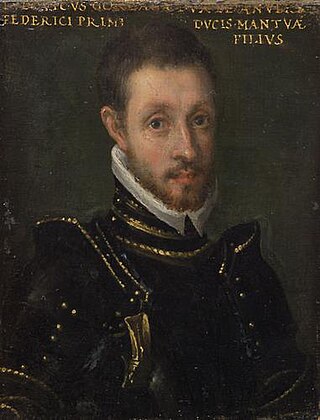
Louis de Gonzague, Duke of Nevers was a soldier, governor and statesman during the French Wars of Religion. His father and brother were reigning dukes of Mantua. He came to France in 1549, and fought for Henri II of France during the latter Italian Wars, getting himself captured during the battle of Saint Quentin. Due to his Italian connections he was seen as a useful figure to have as governor of French Piedmont, a post he would hold until Henri III ceded the territory in 1574. In 1565 his patron, Catherine de' Medici secured for him a marriage with the key heiress Henriette de Clèves, elevating him to duke of Nevers and count of Rethel. He fought for the crown through the early wars of religion, receiving a bad injury in the third war. At this time he formed a close bond with the young Anjou, future king Henri III, a bond that would last until the king's death.

Charles de Bourbon, Cardinal de Bourbon, Archbishop of Rouen was a French noble, prelate and disputed King of France as the Catholic Ligue candidate from 2 August 1589 – 9 May 1590. Born the third son of Charles of Bourbon, Duke of Vendôme and Françoise d'Alençon he was destined for a career in the church. As a member of the House of Bourbon-Vendôme he was one of the premier Prince du sang. Already having secured several sees, he was made a Cardinal by Pope Paul III in January 1548. In 1550 he received the office of Archbishop of Rouen making him the Primate of Normandy. The following year the promotion of Bourbon to Patriarch of the French church was threatened by King Henry II to secure concessions from the Pope. During the Italian Wars which resumed that year, Bourbon played a role by supporting Catherine de Medici's regency governments in France and briefly holding a lieutenant-generalship in Picardy. In 1557 the Pope appointed the Cardinals Bourbon, Lorraine and Châtillon as the leaders of an inquisition in France to root out heresy. The effectiveness of their inquisition would be obstructed by both the king and the Parlements and by July 1558 their appointments were voided by the Parlement of Paris.
Roger de Saint-Lary, baron de Bellegarde (1525-1579) was a soldier and Marshal of France. Rising to prominence as a favourite of Henri III he was quickly elevated to high office, becoming Marshal in 1574. Tasked with leading the main royal army in the fifth war of religion, he was not able to achieve success and the army disintegrated while he attempted to besiege Livron. Fighting again for the crown in 1577 he remained unable to achieve notable success on the battlefield. Having attempted to seize the Marquisate of Saluzzo which he had relinquished in hopes of attaining the governorship of Languedoc, he was granted the territory in a mediated settlement overseen by the duke of Savoy in October 1579. Several months later he would be dead.
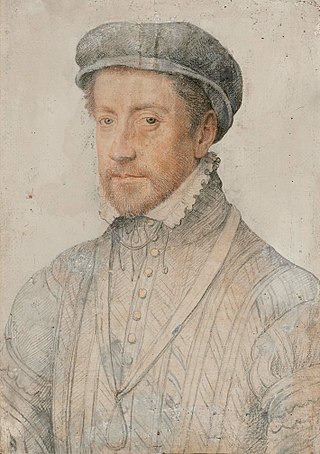
Louis de Bourbon, Duc de Montpensier was the second Duke of Montpensier, a French Prince of the Blood, military commander and governor. He began his military career during the Italian Wars, and in 1557 was captured after the disastrous battle of Saint-Quentin. His liberty restored he found himself courted by the new regime as it sought to steady itself and isolate its opponents in the wake of the Conspiracy of Amboise. At this time Montpensier supported liberalising religious reform, as typified by the Edict of Amboise he was present for the creation of.

Jeanne d'Albret, also known as Jeanne III, was Queen of Navarre from 1555 to 1572.

The siege of Orléans was the final key military engagement of the first French War of Religion. Having lost the Battle of Dreux the rebel Huguenots fell back with their remaining forces to the city. François, Duke of Guise, the only non captive royal commander, moved to lay siege to the town, hoping its capitulation would bring about a total victory for the crowns forces. However, despite reducing the suburbs, he would be assassinated at the siege before he could bring it to a conclusion. As a result the captive Louis, Prince of Condé and Anne de Montmorency at Catherine de' Medici's direction were able to negotiate a compromise end to the first war in the Edict of Amboise.
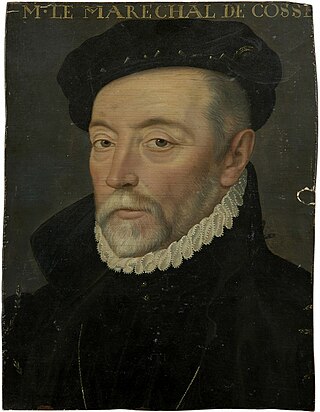
Artus de Cossé, seigneur de Gonnor and Comte de Secondigny (1512–1582), was a Marshal of France, an office he was elevated to in 1567. He served to administer the armies finances during the first of the French Wars of Religion and would lead the royal army in its pursuit of the Prince of Condé during the second civil war. His failure to catch the army led to his dismissal from overall royal command. During the third civil war he would again lead troops, beating a small Protestant force, before being defeated in the final days of the war at Arney-le-Duc. His long history of Politique leanings would push him into the orbit of the Malcontents for which he would be arrested in 1574. In 1576 he would be released and restored to favour before he died in 1582.





















